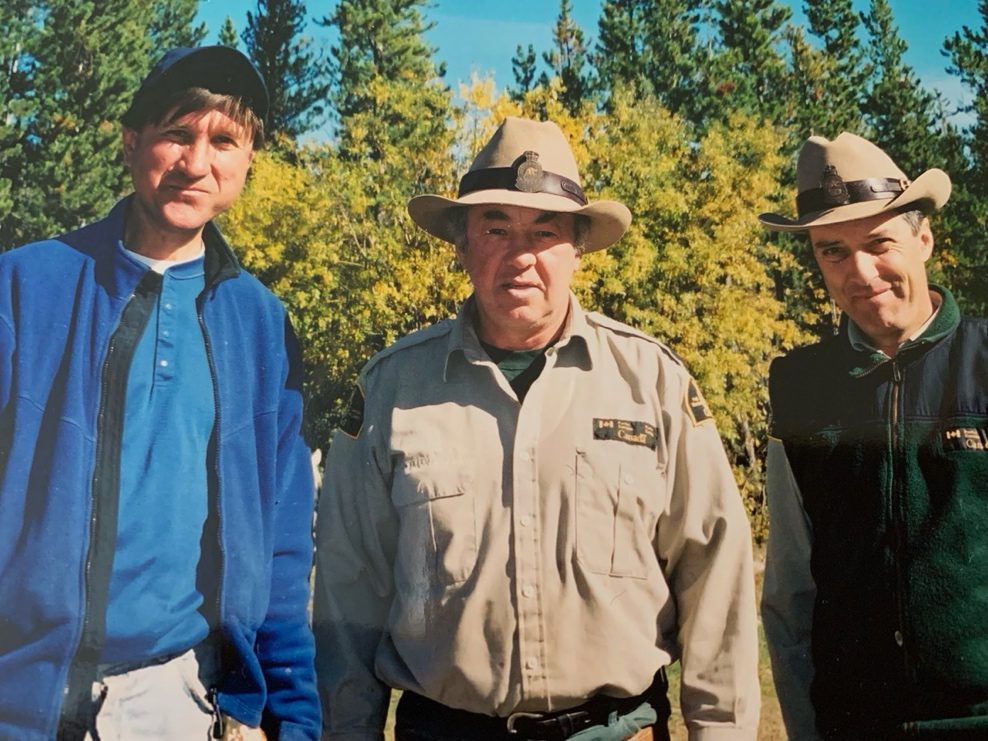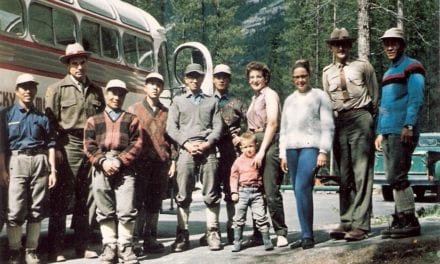In 1984, however, the Mulroney government was elected and they decided to cut a whole bunch of stuff. One of the things they cut was the entire Canadian Wildlife Service Research Unit that did work in the national parks. There were 84 of us across the country.
So, I lost my job and had to find another one. We were given priority for vacant public service jobs and I ended up lucking into a job in Jasper that was vacant at the time. I got hired there as Icefields Area Interpreter working for Jim Todgham. I eventually became Assistant Chief Park Interpreter for Personal programming until 1989. We had four years in Jasper – with two more kids born at that time. Corey was born in Edmonton, and Katie and Brian after we moved to Jasper.
Then I applied for and got the Chief Park Interpreter position in Yoho from ‘89-’91. We didn’t really like living in Field because of the highway issues and travelling through the Kicking Horse Canyon every time we needed groceries or appointments, with a van full of little kids with those semis going past and the smell of burning brakes – we were looking for an escape. I recall spotting a train engine gushing diesel fuel into the ballast on my way home from work one day. I believe Cal Sime was the warden who investigated but the spill was finished when he got there and all the fuel was down in the gravel. I don’t think any charges were ever laid.
I ended up working in the Calgary Regional Office as an interpretive specialist, on the Cultural Heritage side from ‘91 until June of 1992. That was interesting but well outside my skills. We started the Bar U Ranch National Historic Site around then. And then, according to my resume, I became the Chief of Heritage Interpretation for the Western Region in 1992 until April of ‘93. At the time, Parks Canada was going through a huge reorganization. It was a total dog’s breakfast. A horrible period of time.
I took over for Jenny Feick as the Chief (1992- 1993). But Parks Canada had lost the CWS Research Unit and so they had no research capacity – no ability to provide advice on biological matters. The warden service wasn’t really designed that way. Wardens at that time were very much around technical jobs. They were focused on applied ecology, not the research side of things. So, through that reorganization, Parks Canada decided to hire biologists.
There were six vacancies in western Canada. They created new positions that would work in the warden service. Bill Dolan, Chief Park Warden for Waterton, was in charge of the selection process. I think he was not initially too thrilled about giving me the job because of my lack of warden experience. I just figured I was already pre-qualified for the job since I’d been working as BI2 in the CWS and that’s what they were hiring. Bill’s view was that these were like assistant chief warden positions sort of things, and they should go to wardens with experience and I had no work experience. So, they couldn’t really ‘disqualify’ me, so I came out #6 on the list and I ended up working with Bill Dolan – and it was great.
And I ended up working in Waterton Lakes National Park.
Laura: And this was your first park as a biologist.
Kevin: Yes. That was from 1993 until July 2000. But because Bill had that view, that you had to earn your stripes to become a biologist, he would not let me do any biology work at first. My first year I had to work as a warden. So, I went to warden school that year (1993)…I was probably the world’s worst warden.
Laura: Why do you say that?
Kevin: Well because I had no real previous experience. But it was quite smart on Bill’s part because as a 40 year old warden I was out of my depth, and I was working with wardens who had been around a lot longer. It created a really good dynamic. Instead of coming in as a well-paid, know-it-all biologist I came in sort of as their junior and then became a part of the team as a rookie.
To me, as it turned out, it was frustrating because I thought I was being overpaid for doing sub-adequate work. But in the long run, it paid off. I had that experience of working as the least competent member on the team and having to rely on everybody else to show me the ropes. Derek Tilson and Keith Brady were particularly generous with me. Other wardens I worked with there were Brad Kozachenko, Mary Coleman, and Peter Jowett. When Peter arrived, I had to watch out, because he was quite a prankster. I spent ten frustrating minutes on the phone trying to explain to some German guy that we didn’t have spare elk for sale before I heard Peter chuckling in the next office – it had been him the whole time. So that was 1993-2000.
Laura: What did you like most about being associated with the warden service?
Well before I get to that I guess I’d better finish the tale of the unfolding career. I left Waterton in July 2000 to become the manager of Jasper’s ecosystem secretariat, which was a strange creation. It involved planning and environmental assessment. It was a totally redundant position because the responsibilities were mostly really ones that belonged in Resource Conservation. We went through another process of organizational review and I helped to talk Parks Canada out of having ecosystem secretariats – and lost my job as a result of that – because I was successful in my argument! But at the time, Brian Wallace was getting ready to retire as the chief up there, and I took over as the manager of Resource Conservation from June of 2004 until October of 2005. That didn’t work out.
Laura: What were some of the things that didn’t work out?
Kevin: I was only acting in that position. Gaby Fortin wouldn’t allow me to be confirmed in it as an indeterminate position. So, I had to find something else. I ended up applying for a superintendent competition and I became the superintendent of the Northern Prairies Field Unit from October 2005 until January 2008. Then I applied for two positions in Alberta because we really wanted to get out of that situation. It wasn’t really working out too well for Gail. Far from the kids, no work for her, and a very closed and nosy social clique in the Waskesiu cottage/cabin community that made us feel constantly under a critical and unfriendly microscope. I applied for Jasper and Banff Superintendent, thinking they might hire me for Jasper, but instead I got the Banff job. So, from 2008 to 2011, I worked in Banff as Superintendent and I retired in 2011.
So that’s that story.

Ed Struzik (Canadian Press), Brian Wallace and Kevin Van Tighem,
about to head into the Jasper North Boundary, summer 2003.
Laura: So, the main responsibilities for you (over the years) was largely in science and research.
Kevin: I would say I spent a third of my career in park interpretation, a third in science and research, and a third in management. That would be the summary of it.
Laura: So…rule of thirds:) And, what was the most rewarding would you say?
Kevin: It’s just so hard to say.
Laura: Looking at those thirds, what do you think was the most worthwhile?
Kevin: Some things are right for the stage of your life that you’re in and they wouldn’t have been for a different stage. I absolutely loved my time with the Canadian Wildlife Service working on the wildlife inventory, especially in Jasper. Those were GOOD years! So much backcountry time, so much stuff to learn. And then Waterton was really, really good. It was good for the family; it was good for me. Especially before Bill and I realized that I had to get on with what the job was really about and not just what I liked doing. Because at first it was working on cross-border conservation strategies, but it was really meant to involve a lot more of the ecological monitoring work inside the park. So, those would have been the best parts.




A really good interview. Kevin had challenging management decisions for a challenging time in Parks Canada!
Good job Laura!